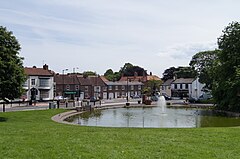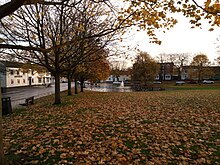Norton, County Durham
This article needs additional citations for verification. (August 2009) |
| Norton | |
|---|---|
 Village Green at Norton | |
Location within County Durham | |
| OS grid reference | NZ443217 |
| Unitary authority | |
| Ceremonial county | |
| Region | |
| Country | England |
| Sovereign state | United Kingdom |
| Post town | STOCKTON-ON-TEES |
| Postcode district | TS20 |
| Dialling code | 01642 |
| Police | Cleveland |
| Fire | Cleveland |
| Ambulance | North East |
| UK Parliament | |
Norton is a town in the unitary authority of Stockton-on-Tees and the ceremonial county of County Durham, England.
Norton stands on rising ground west of Billingham Beck, which flows south-east to join the River Tees. Blakeston is in the north-west of the parish and Hardwick in the west; between them lie Middlefield and Howden. Ouston Moor is in the south-west corner, Newham and Ragworth lie near the south, and Holme House Prison in the south-east.
The original village dates back to at least the Anglo-Saxon period. Once a market town, for centuries Norton was the centre of an important parish that included Stockton, but its status was reversed in 1913 and Norton became a part of the borough of Stockton on Tees. In 1968 Norton became a part of Teesside County Borough. In 1974 Teesside County Borough was abolished. Norton became a part of the reconstituted and significantly bigger Borough of Stockton-on-Tees, in the new County of Cleveland. Stockton-on-Tees became a unitary authority in 1996.
Norton Village

Norton village consists of a wide, tree-lined High Street with a number of shops, hairdressers, boutiques and cafés, a library, photographic studio and a traditional fish & chips shop, as well as a mixture of 18th century and 19th century townhouses, cottages and modern apartments. To the south end of High Street, the Victoria Jubilee Memorial Cross stands where the market place was once situated. The red sandstone Anglian style cross commemorates Queen Victoria's Diamond Jubilee in 1897. Further along, and on the opposite side of the High Street are the Fox almshouses, also founded in 1897 at the bequest of local brewer John Henry Fox. At the north end there is a large village green with a duckpond, surrounded by mostly Georgian houses and cottages. The ancient parish church of St. Mary the Virgin stands dominantly on the west side of the village Green. The buildings in the middle of the Green now house a newsagent shop, cafe and community hall where once a blacksmith's forge stood. Away from the village lie the housing estates of Albany, Glebe, Crooksbarn and Norton Grange (originally Blue Hall).

In 1982, the chance discovery of human bones by school children playing on a rope swing near the Mill Lane area of the village, led to the unearthing of an Anglo-Saxon pagan cemetery. Excavations in 1984 revealed 120 burials (117 inhumations and 3 cremations) in graves that contained assorted personal items such as spears, belt buckles and brooches. The remains and objects collected suggest the site was dated to around AD 540–610.

St Mary's Church
St Mary the Virgin, the ancient parish church that stands on the village green, is the only cruciform Anglo-Saxon church in northern England. Its crossing tower with eight triangular head windows has a battlemented top of later date, and there is a 14th-century effigy of a knight in chainmail. Residing under the church floor there is claimed to be an escape tunnel used by the Saxons and priests when in danger, though it may be a drainage culvert. The tunnel leads under the church floor and Norton Green, eventually surfacing in the Albany housing estate. The church floor was recently renovated and Saxon remains and artefacts were discovered in the tunnel entrance[citation needed]. St Mary's was until the Reformation a Catholic Church.
The grave of John Walker, the inventor of friction matches, is located in the churchyard.[1]
Norton's Catholic population now worship at St Joseph in Darlington Lane. The church opened in 1933 and is part of the St Hilda Partnership within the Hexham and Newcastle Diocese. The current priest is Fr Jeff Dodds.
Red House School
Located in the village is Red House School, an independent school established in 1929. Adjacent to St. Mary's Church is Red House Nursery & Infant School, which combines state of the art modern buildings with classrooms in the former Old Vicarage. On the opposite side of the village green resides Red House Preparatory and Main School. In May 2012, the school announced its intention to relocate to nearby Wynyard Park stating that it had outgrown its existing site in Norton. This, however, did not occur as the school decided to improve the existing site.
Pubs, Cafés and Restaurants

Norton is home to a number of pubs: Norton Tavern, CiC@74 (known as Norton Cricket Club by locals),The Centenary, The Unicorn (known as The Top House by locals), The George and Dragon, The Highland Laddie, The Malleable Social Club, Connections, Red Lion, Norton Working Men's Club, The Head Of Steam, Hydes Bar, Alitheos and Canteen and Cocktails. The village also has a number of restaurants and cafés including Scrann, The Open Jar, 12 Harland Place, Cafe Lilly and Cafe Maison.
Sport
The Norton (Teesside) Sports Complex is situated on Station Road and dates back to 1847 when it was the home of Norton Cricket Club. At the Club's Centenary Dinner in 1947, the members decided to buy the ground (and a further twelve acres surrounding it) with a view to developing it into one of the finest sports complexes in the north of England. During the past few decades further land was acquired and now as well as being home to Norton Cricket Club, it provides facilities for a number of other sports, including: squash, tennis, hockey, bowls, five-a-side football, archery and boxfit.
The complex is also home to the Billingham Synthonia Football Club and is now again home to Norton & Stockton Ancients Football Club, reinstated in 2019 having folded 3 years previously in 2016.
Notable events
6 August 1856, John Warner and Sons cast the first bell for Big Ben, but it cracked beyond repair while being tested at Westminster. Another bell was later recast at the Whitechapel Bell Foundry in London.
14 July 1977, Queen Elizabeth II passed through Norton by car, in front of spectators during her Silver Jubilee royal visit to the region.
11 November 2006, Dragon's Den businessman Duncan Bannatyne (who owned a house on the High Street at the time, later moving to nearby Wynyard Park) was married at St Mary's Church in Norton. Celebrities at the ceremony included Anna Ryder Richardson, Cherie Lunghi, Gary McCausland, Dragons' Den presenter Evan Davis and fellow Dragons Theo Paphitis, Richard Farleigh, Simon Woodroffe and Deborah Meaden[2]
Image gallery
-
Fox Almshouses
-
High Street
-
1897 Jubilee Memorial Cross
Notable people from Norton
- Geoff Deehan – Television and Film Producer
- Thomas Jefferson Hogg – barrister and writer
- Stevie Lynn – professional wrestler
- Christopher Middleton – navigator
- Gary Pallister – professional footballer with Middlesbrough, Manchester United and England
- Franc Roddam – film director
- David Townsend – Test cricketer
- Peter Townsend – cricketer
- John Walker (1781–1859), inventor of the friction match, buried in the grounds of St Mary's Church, Norton
- Polycarpus Taylor – rear admiral 1757-1762, HMS Marlborough [3]
References
- ^ http://www.stmarysnorton.org.uk/
- ^ "Archived copy". Archived from the original on 10 December 2009. Retrieved 26 September 2009.
{{cite web}}: CS1 maint: archived copy as title (link) - ^ http://freepages.history.rootsweb.ancestry.com/~bldr/admiral.html
External links
![]() Media related to Norton, County Durham at Wikimedia Commons
Media related to Norton, County Durham at Wikimedia Commons




